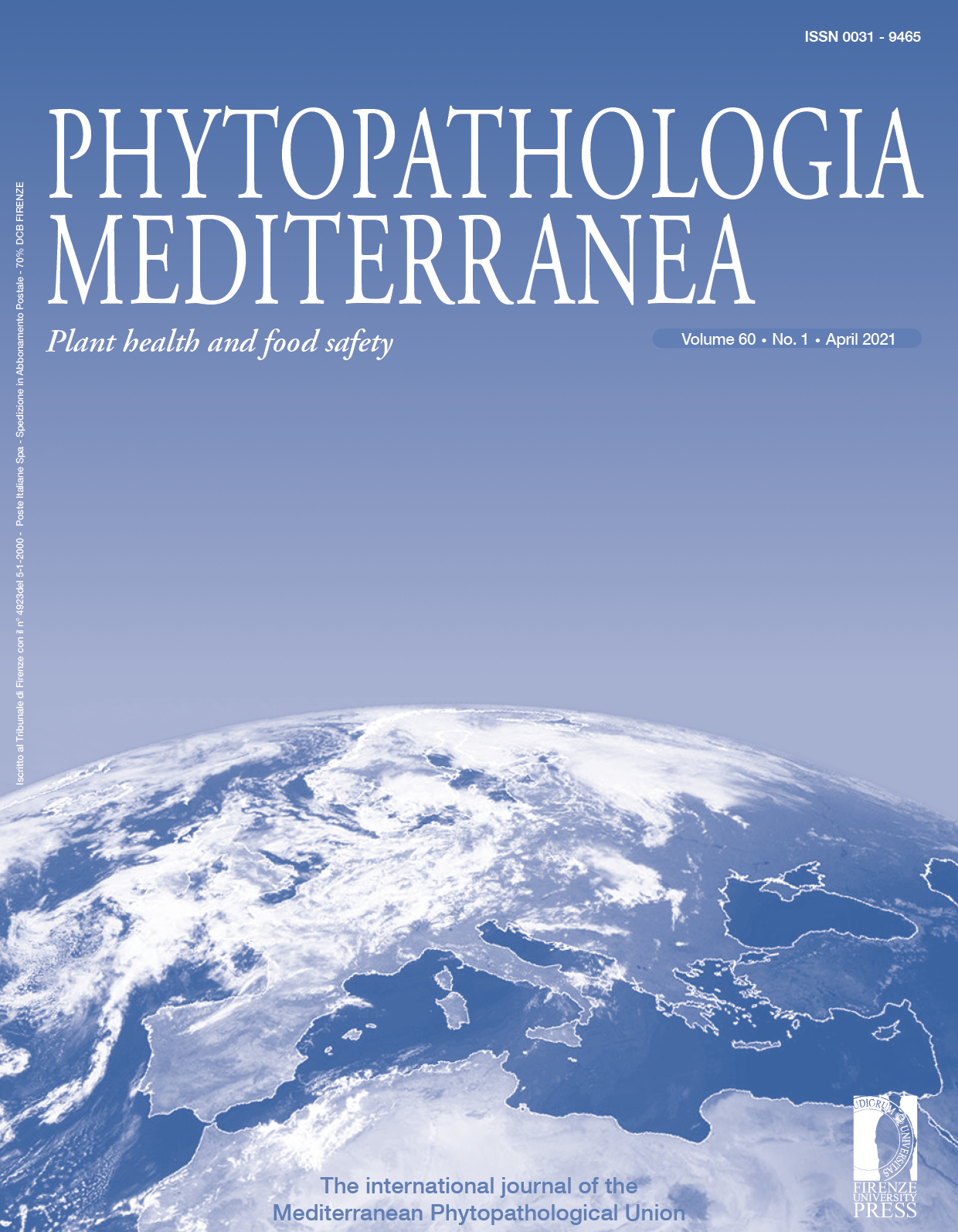Molecular and serological detection of Parietaria mottle virus in Phytolacca americana, a new host of the virus: Phytolacca americana host of PMoV
Published 2021-05-13
Keywords
- PMoV,
- alien species,
- American pokeweed,
- natural host,
- emerging viruses
How to Cite
Funding data
Abstract
Parietaria mottle virus (PMoV) is an emerging virus in Mediterranean countries, responsible for severe disease in tomato and pepper crops in the field and protected cultivation. The principal wild reservoir of PMoV is Parietaria officinalis, and only few additional wild plants have been described as natural reservoirs of the virus. During field survey in southern Italy, several plants of Phytolacca americana showing virus-like symptoms were collected. Serological and molecular assays showed that these plants were infected by PMoV. Sequence comparison of the movement protein gene of the PMoV isolate from P. americana showed the greatest similarity to the corresponding sequence from tomato plants growing nearby. These results indicate that P. ameriacana is a new natural host of PMoV, and further investigation is warranted to establish the potential of this host as reservoir of the virus in the field.
Downloads
References
Aramburu, J., Galipienso, L., Aparicio, F., Soler, S., Lopez, C., 2010. Mode of transmission of Parietaria mottle virus. Journal of Plant Pathology 92: 679-684.
Bonanomi, G., Incerti, G., Abd El-Gawad, A. M., Sarker, T.C., Stinca, A., Motti, R., Cesarano, G., Teobaldelli, M., Saulino, L., Cona, F., Chirico, G.B., Mazzoleni, S., Saracino, A., 2018. Windstorm disturbance triggers multiple species invasion in a Mediterranean forest. iForest 11: 64-71.
Caruso, G., Parrella, G., Giorgini, M., Nicoletti, R., 2018. Crop systems, quality and protection of Diplotaxis tenuifolia. Agriculture, 8(49): 55. https://doi.org/10.3390/agriculture8040055
Cuénoud, P., Savolainen, V., Chatrou, L.W., Powell, M., Grayer, R.J., Chase, M.W., 2002. Molecular phylogenetics of Caryophyllales based on nuclear 18S rDNA and plastid rbcL, atpB, and matK DNA sequences. American Journal of Botany 89: 132-144.
Galasso, G., Conti, F., Peruzzi, L., Ardenghi, N.M.G., Banfi, E., Celesti-Grapow, L., Albano, A., Alessandrini, A., Bacchetta, G., Ballelli, S., Bandini, Mazzanti, M., Barberis, G., Bernardo, L., Blasi, C., Bouvet, D., Bovio, M., Cecchi, L., Del Guacchio, E., Domina, G., Fascetti, S., Gallo, L., Gubellini, L., Guiggi, A., Iamonico, D., Iberite, M., Jiménez-Mejías, P., Lattanzi, E., Marchetti, D., Martinetto, E., Masin, R.R., Medagli, P., Passalacqua, N.G., Peccenini, S., Pennesi, R., Pierini, B., Podda, L., Poldini, L., Prosser, F., Raimondo, F.M., Roma-Marzio, F., Rosati, L., Santangelo, A., Scoppola, A., Scortegagna, A., Selvaggi, A., Selvi, F., Soldano, A., Stinca, A., Wagensommer, R.P., Wilhalm, T., Bartolucci, F., 2018. An updated checklist of the vascular flora alien to Italy. Plant Biosystems 152: 556-592.
Galipienso, L., Martinez, C., Willemsen A., Alfaro-Férnandez, A., Font-San Ambrosio, I., Davino, S., Rubio, L., 2015. Genetic variability and evolutionary analysis of parietaria mottle virus: rle of selection and genetic exchange. Archives of Virology 160: 2611-2616.
Janssen, D., Saez, E., Segundo, E., Martin, G., Gil, F., Cuadrado I.M., 2005. Capsicum annuum – a new host of Parietaria mottle virus. Plant Pathology 54: 567.
Lee, J., Kim, S.Y., Park, S.H., Ali, M.A., 2013. Molecular phylogenetic relationships among members of the family Phytolaccaceae sensu lato inferred from internal transcribed spacer sequences of nuclear ribosomal DNA. Genetics and Molecular Research 12: 4515-4525.
Marchoux, G., Parrella, G., Gebre-Selassie, K., Gognalons P., 1999. Identification de deux ilarvirus sur tomate dans le sud de la France. Phytoma, 522: 53-55.
Parrella, G., 2002. First report of Parietaria mottle virus in Mirabilis jalapa. Plant Pathology 51: 401.
Parrella, G., Greco, B., Troiano, E. 2016. Severe symptoms of mosaic and necrosis in bell pepper associated with parietaria mottle virus in Italy. Plant Disease 100: 1514.
Parrella, G.; Greco, B., Troiano, E., 2017. First report of parietaria mottle virus associated with yellowing disease in Diplotaxis tenuifolia in Italy. Plant Disease 101: 850-851.
Parrella, G., Troiano E., Cherchi C., Giordano P., 2020. Severe outbreaks of parietaria mottle virus in tomato in Sardinia, southern Italy. Journal of Plant Pathology, 102: 915.
Parrella, G., 2020. Sources of resistance in wild Solanum germplasm (section Lycopersicon ) to parietaria mottle virus, an emerging virus in the Mediterranean basin. Plant Pathology 69: 1018-1025.
Ramasso, E, Roggero, P, Dellavalle, G, Lisa, V, 1997. Necrosi apicale del pomodoro causata da un Ilarvirus. Informatore Fitopatologico 1:71-77.
Rettig, J.H., Wilson, H.D., Manhart, J.R., 1992. Phylogeny of the Caryophyllales - gene sequence data. Taxon 41: 201-209.
Roggero, P., Ciuffo, M., Katis, N., Alioto, D., Crescenzi, A., Parrella G., Gallitelli D., 2000. Necrotic disease in tomatoes in Greece and southern Italy caused by a tomato strain of Parietaria mottle virus. Journal of Plant Pathology 82: 159.
Stinca, A., Motti, R., 2017. Alien plant invasions in Astroni crater, a decades-long unmanaged forest in southern Italy. Atti della Società Toscana di Scienze Naturali, Memorie Serie B, 124: 101-108.
Tamura, K., Stecher, G., Peterson, D., Filipski, A., Kumar, S., 2013. MEGA6: Molecular evolutionary genetics analysis version 6.0. Molecular Biology & Evolution 30: 2725-2729.







